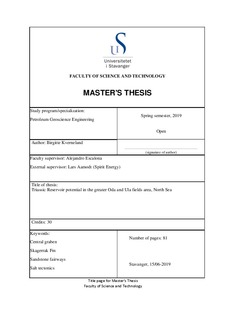| dc.contributor.advisor | Escalona, Alejandro | |
| dc.contributor.advisor | Aamodt, Lars | |
| dc.contributor.author | Kverneland, Birgitte | |
| dc.date.accessioned | 2019-10-01T12:23:18Z | |
| dc.date.available | 2019-10-01T12:23:18Z | |
| dc.date.issued | 2019-06 | |
| dc.identifier.uri | http://hdl.handle.net/11250/2619630 | |
| dc.description | Master's thesis in Petroleum Geosciences Engineering | nb_NO |
| dc.description.abstract | The objective of this thesis is to improve the understanding of the lateral distribution of the sandstones of the Skagerrak Fm, by using 3D seismic data and wells in the greater Oda and Ula field area. The Oda and Ula fields are located in the salt province in the Central Graben. Consequently, salt tectonics played an important role in the deposition of the Skagerrak Fm sands, resulting in a large lateral variation in thickness and facies. The composition of the salt also has a large impact on the supra-salt structural style, and furthermore the sedimentation of the Skagerrak Fm.
The interaction between salt tectonics and sedimentation is investigated in order to understand how salt related subsidence or uplift acted as depocenters for sedimentation. The main aim is to understand the facies distribution, to further build a conceptual model for sandstone fairways, and ultimately point to areas where there can be good quality reservoir potential in the Triassic.
Most wells in the salt province are placed in an interpod setting where the Skagerrak Fm is very thin or absent, since it has not traditionally been the main target. However, it is a proven working play, and is being produced in the Ula Field. It is therefore likely that there are commercial accumulations of oil other places as well in the Triassic section in the area.
Two different salt regimes has been defined, where one salt unit is mobile and halite-dominated. The other salt unit is interbedded with carbonates and anhydrite, and consequently a lot more viscous and non-mobile. The two salt regimes result in different subsalt structural style. The mobile salt unit result in a pod-area where accommodation space is created next to large salt structures, where the Skagerrak Fm sandstone can be deposited and preserved. In contrast, in the area of the non-mobile unit the Triassic thickness is relatively constant and the Top Triassic surface has a gentle topography.
The Skagerrak Fm is a part of a regional fluvial alluvial system, and is locally interpreted to be in a braided streams depositional environment with ephemeral lakes. Rivers have been directed into the pods, where there has been accommodation space for sediments to be deposited, and it is suggested that there is a good Triassic reservoir potential within the pods. The interpod area is farther away from the channel feeder, well logs show less developed sand packages and has possibly lower reservoir potential. | nb_NO |
| dc.language.iso | eng | nb_NO |
| dc.publisher | University of Stavanger, Norway | nb_NO |
| dc.relation.ispartofseries | Masteroppgave/UIS-TN-IER/2019; | |
| dc.subject | petroleumsgeologi | nb_NO |
| dc.subject | Central graben | nb_NO |
| dc.subject | Skagerrak Fm | nb_NO |
| dc.subject | sandstone fairways | nb_NO |
| dc.subject | salt tectonics | nb_NO |
| dc.title | Triassic Reservoir potential in the greater Oda and Ula fields area, North Sea | nb_NO |
| dc.type | Master thesis | nb_NO |
| dc.subject.nsi | VDP::Technology: 500::Rock and petroleum disciplines: 510::Geological engineering: 513 | nb_NO |
| dc.subject.nsi | VDP::Mathematics and natural science: 400::Geosciences: 450::Petroleum geology and petroleum geophysics: 464 | nb_NO |
